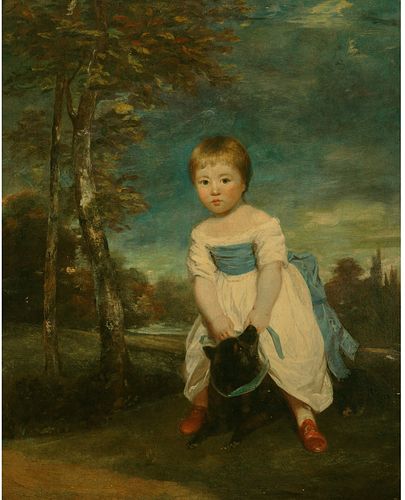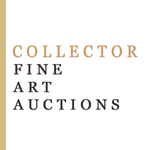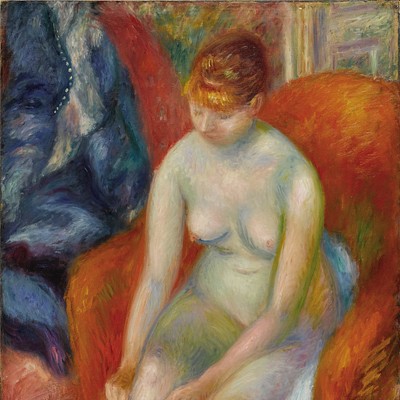Joshua Reynolds, British, 1723-1792
Lot 108
Estimate:
$200,000 - $300,000
Absentee vs Live bid
Two ways to bid:
- Leave a max absentee bid and the platform will bid on your behalf up to your maximum bid during the live auction.
- Bid live during the auction and your bids will be submitted real-time to the auctioneer.
Bid Increments
| Price | Bid Increment |
|---|---|
| $0 | $10 |
| $100 | $25 |
| $500 | $50 |
| $1,000 | $100 |
| $2,000 | $250 |
| $5,000 | $500 |
| $10,000 | $1,000 |
| $20,000 | $2,500 |
| $50,000 | $5,000 |
| $100,000 | $10,000 |
About Auction
By Collector Fine Art Auctions
Feb 4, 2023
Set Reminder
2023-02-04 11:30:00
2023-02-04 11:30:00
America/New_York
Bidsquare
Bidsquare : Fine European / American Paintings & Furniture
https://www.bidsquare.com/auctions/collector-fine-art-auctions/fine-european-american-paintings-furniture-12048
Collector Fine Art Auctions February 4, 2023 / 11:30 am European / American Paintings & Furniture. First Annual Sale from Tuxedo Park NY, 150 Central Park South NYC, Princeton NJ Collector Fine Art Auctions cfaauction@gmail.com
Collector Fine Art Auctions February 4, 2023 / 11:30 am European / American Paintings & Furniture. First Annual Sale from Tuxedo Park NY, 150 Central Park South NYC, Princeton NJ Collector Fine Art Auctions cfaauction@gmail.com
- Lot Description
Title: Portrait of Master William Cavendish, standing astride a black dog, in a landscape
Medium: Oil on canvas. Signed on the reverse.
Size: 50 x 40 in. (127 x 101.6 cm.)
PROVENANCE:
The sitter; Lord Chesham of Latimer, Chesham, Buckinghamshire, by descent from the above. Knoedler & Co., London, acquired from the above, 1922. Private collection, acquired from the above, circa 1938. Private collection, by descent from the above. Sotheby's, New York, June 5, 2008, lot 88. Acquired by the present owner from the above.
EXHIBITION:
Agnew's Galleries, London, 1904, no. 12 (lent by Lord Chesham); M. Knoedler & Co. Inc., London, "A Loan Exhibition of English XVIIIth Century Portraits of Children," April 24-May 23, 1931, no. 15; Fogg Art Museum, Cambridge, Massachusetts, "Exhibition of Eighteenth-Century English Painting in Honor of Professor Chauncey B. Tinker of Yale," May 5-19, 1930, no. 70 (on loan from Knoedler's); Union League Club, New York, "Exhibition of Paintings of the 18th Century School," February 10-19, 1933, no. 19; Rijksmuseum, Amsterdam, "Tentoonstelling van Oude Kunst," 1936, no. 129; Washington Gallery, February 1938.
LITERATURE:
T. Taylor and C.R. Leslie, Life and Times of Sir Joshua Reynolds with Notices of Some of his Contemporaries, Vol. II, London, 1865, p. 468; F. G. Stephens, English Children as Painted by Sir Joshua Reynolds, London, 1884, p. 75.
Sir W. Armstrong, Sir Joshua Reynolds, First President of the Royal Academy, London, 1900, p. 199; A. Graves and W. V. Cronin, A History of the Works of Sir Joshua Reynolds, P.R.A., London, 1899, Vol. I, p. 160.
E.K. Waterhouse, Reynolds, London, 1941, p. 76; D. Mannings, Sir Joshua Reynolds, A Complete Catalogue of His Paintings, Vol. I, London, 2000, p. 127, cat. no. 338, p. 599, vol. II, p. 539, fig. 1429
ENGRAVED:
S.W. Reynolds (and other eminent engravers), Engravings from the Works of Sir Joshua Reynolds, P.R.A., Vol. III, n.p., no. 20.
Although Sir Joshua Reynolds' resplendent portraits of fashionable London society won the artist considerable fame and recognition, his endearing portraits of children are widely regarded among his most brilliant accomplishments. Reynolds' uncanny aptitude for capturing the innocent candor of childhood is clearly visible in the present portrait, in which the young child, William Cavendish, stares so inscrutably at the viewer while seated playfully astride his pet dog. Curiously, his stare is hard to read. Is that because we are no longer children, have lost our own innocence, and tend to overly scrutinize everything in a search of a narrative? The composition is very much in keeping with contemporary views on sensibility and the emotions of the heart: the viewer cannot help but feel a tender regard for the young boy who is playing, yet seems to have frozen in front of us, as though his fantasy has been interrupted.
This fascinating portrait was painted in 1784, the same year that young William's aunt Georgiana, Duchess of Devonshire, sat to Reynolds with her infant daughter Lady Georgiana Cavendish, resulting in the justly famous painting of maternal affection now in the Devonshire collection at Chatsworth. Play rests at the heart of that painting as well, as the little girl lifts her arms in a gesture of joy and abandon as encouraged by her mother. There's a sense in both paintings that childhood is a precious time, precious in part because it, and all its magic, is so fleeting.
The sitter of the present work, William Cavendish (1783-1812), was the eldest son of Lord George Cavendish, later Lord Burlington, and Lady Elizabeth Compton. He was elected Member of Parliament for Knaresborough in 1804 and then for Derby in 1806 which he represented until his tragic early death at the age of 29 when he was flung from his curricle on his way back from a shooting excursion. His eldest son William (1808-1891) succeeded as the 7th Duke of Devonshire.
This portrait of Francis George Hare is the most famous picture by Reynolds in France. A young boy with long hair, about two years old, is shown wearing very young child's clothes. He is dressed in a chiffon outfit, as children of his age and class were. This picture swiftly became famous and is one of the archetypal images of British art. donated by Rothschild to Louvre Museum Paris in 1905. - Shipping Info
-
Collector Fine Art Auctions requires "Third Party Shipping". We suggest requesting a quote for packing and shipping prior to bidding on an item, as you will be responsible for collection or shipping if you are the successful bidder. As a convenience to the buyer Collector Fine Art Auctions will make a referral for packing and shipping. This is at the request, expense and risk of the buyer and Collector Fine Auctions assumes no liabilities /responsibilities for the items or timing of delivery insurance for in transit items is the responsibility of the buyer Items need to be paid and picked up within 10 business days from close of Auction.
-
- Buyer's Premium



 EUR
EUR CAD
CAD AUD
AUD GBP
GBP MXN
MXN HKD
HKD CNY
CNY MYR
MYR SEK
SEK SGD
SGD CHF
CHF THB
THB












